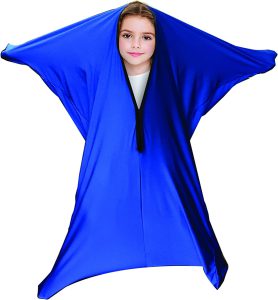Sleep is essential for children’s physical and mental health, but for some children, getting a good night’s rest can be a challenge. This is especially true for children with sensory processing disorders or those who have trouble sleeping due to various reasons. Fortunately, there are tools and strategies available that can help improve sleep quality, and one of those tools is a body sock.
In this guide, we’ll provide an in-depth look at body socks and how they can be used to improve children’s sleep. We’ll cover the benefits of body socks, how to choose the right one for your child, and how to incorporate it into a bedtime routine. We’ll also provide tips on monitoring the effectiveness of body socks and share some real-life examples of how they have helped children sleep better.
What are Body Socks?
Body socks, also known as sensory sacks or compression sacks, are stretchy fabric sacks that cover the entire body, leaving only the head exposed. They are made of materials such as Lycra or spandex and provide a snug, comforting feeling that can help children feel more relaxed and calm.
Body socks are designed to provide deep pressure and proprioceptive input, which can have a calming effect on the nervous system. This is especially beneficial for children with sensory processing disorders or those who have trouble sleeping due to anxiety, hyperactivity, or other reasons.
Benefits of Body Socks for Sleep
There are several benefits to using body socks for sleep. Firstly, they provide deep pressure that can help regulate the nervous system and reduce anxiety, which can be a major barrier to falling asleep. Secondly, they can help children feel more secure and comfortable, which can make it easier for them to relax and drift off to sleep.
Additionally, body socks can provide a sense of containment, which can be especially helpful for children who have trouble with spatial awareness. By providing a defined boundary around the body, body socks can help children feel more grounded and centered, which can help promote a sense of safety and security.
Choosing the Right Body Sock
When choosing a body sock, there are several factors to consider. Firstly, you’ll want to make sure the size is appropriate for your child. Body socks come in different sizes, so be sure to measure your child and consult the manufacturer’s sizing chart to ensure a proper fit.
You’ll also want to consider the material of the body sock. Some children may prefer a softer, more lightweight material, while others may benefit from a more heavy-duty fabric that provides more pressure.
Another factor to consider is the color and design of the body sock. Some children may prefer a specific color or pattern, while others may not have a preference. It’s important to choose a body sock that your child is comfortable with and enjoys wearing.
Incorporating Body Socks into a Bedtime Routine
Once you’ve chosen a body sock for your child, it’s important to incorporate it into a bedtime routine. This can help your child associate the body sock with sleep and create a sense of consistency and routine.
A bedtime routine can include activities such as brushing teeth, reading a book, singing a lullaby, and putting on the body sock. You may also want to consider incorporating other calming activities such as deep breathing or gentle massage to help your child relax even further.
Monitoring the Effectiveness of Body Socks
It’s important to monitor the effectiveness of body socks to ensure they are helping your child sleep better. This may involve keeping a sleep diary or using a sleep tracking app to monitor your child’s sleep patterns.
You may also want to consult with a healthcare professional or occupational therapist to ensure the body sock is being used correctly and to discuss any other strategies that may be beneficial for improving your child’s sleep.
